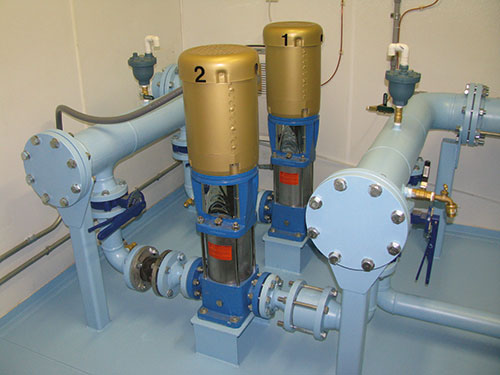Pumps & Systems, March 2013
Innovation comes in many forms. After many years of struggling with water quality and dependability, the residents of the Pheasant Hill Subdivision formed their own Pheasant Hill Water Corporation. They worked with their consultant, Clark Patterson, to perform a needs assessment and applied for a Drinking Water State Revolving Fund (DWSRF) grant. They were successful and received a $2-million grant and an additional $600,000 in low-interest financing.
Design
Clark Patterson designed the new water treatment system, which included two wells, No. 4 and No. 6; a chlorination system; a pumping system; and a new 30,000 gallon storage tank (see Image 1). Since this system’s source was a well, it has filtration avoidance, and chlorination is the only treatment. Space for a new cartridge filtration system was designed within the water treatment plant, in case the wells are reclassified in the future.

Image 1. The water treatment plant included pressure-maintaining
booster pumping and metering capabilities.
Construction
Once funding was in place, the design, construction and start-up of the new water treatment plant and storage tank was on a fast-track schedule. Clark Patterson evaluated the cost of building the water treatment plant in-place. The design firm also examined an innovative approach of working with a pump station manufacturer to design a prefabricated water treatment and pumping system. The evaluation showed that the prefabricated concept was more expedient and more cost-efficient.
The installing contractor awarded the pumping system contract to Dakota Pump Inc. The 14-foot wide by 51-foot long by 13-foot high, prefabricated water treatment building is a multi-room water treatment plant that includes:
- A stand-by generator room
- Space for future filtration equipment
- A chlorination room
- A separate room for pumps and controls
The stand-by generator with automatic transfer switch comes on when a loss of power occurs (see Image 2). This allows the plant to continue operation. The variable-frequency-driven booster pumps maintain adequate pressure in the distribution water main, and the chemical feed equipment provides proper disinfection. Controls were also a key factor for the station. When the tank level lowers to a pre-determined point, the controls call for the well pumps to start. The components were incorporated into a pre-manufactured and prefabricated water treatment plant.

Image 2. A natural gas-fired generator with automatic transfer
switch provided emergency power service.
Appearance
The appearance of the treatment plant was another consideration. Since the project was located in a residential setting, the designers wanted the building to have an appropriate residential look. Dakota Pump Inc worked with the Pheasant Hill Water Corporation and Clark Patterson to incorporate standard 2-inch by 6-inch construction on a prefabricated steel base plate, reinforced to accommodate the structural needs of the water equipment and the building.
The structural base, walls and ceiling received a high R-value coating of spray foam insulation, and the exterior of the building was covered with architectural horizontal siding. With the help of the consultant, the owner was able to choose the style and color for the siding, the type of soffit and fascia, and the color for the laminated asphalt roof shingles. The result was a treatment building that looks professional and blends with the foliage of the Pheasant Hill subdivision.
Installation
Prefabricating the water treatment plant building allowed the construction of the treatment plant at the factory to coincide with the general contractor’s site preparation. This provided a shorter construction window. Once the construction site was fully prepped and the prefabricated water treatment plant was constructed and factory tested, the treatment plant was transported via a specialized tractor-trailer from Mitchell, S.D., to Minisink, N.Y. (see Image 3).

Image 3. The oversized treatment system and building was transported via specialized hauler from Mitchell, S.D., to Minisink, N.Y.
After the station arrived at the site, it was lifted into place onto the concrete foundation. The inlet and outlet connections were made, and the electrical hook-up was completed.
The station was ready for start-up and commissioning. With this treatment plant, the Pheasant Hill residents have reliable and safe drinking water at consistent pressures and sufficient storage for all conditions. The prefabricated approach saved the residents money and allowed the project to be completed on schedule. P&S

